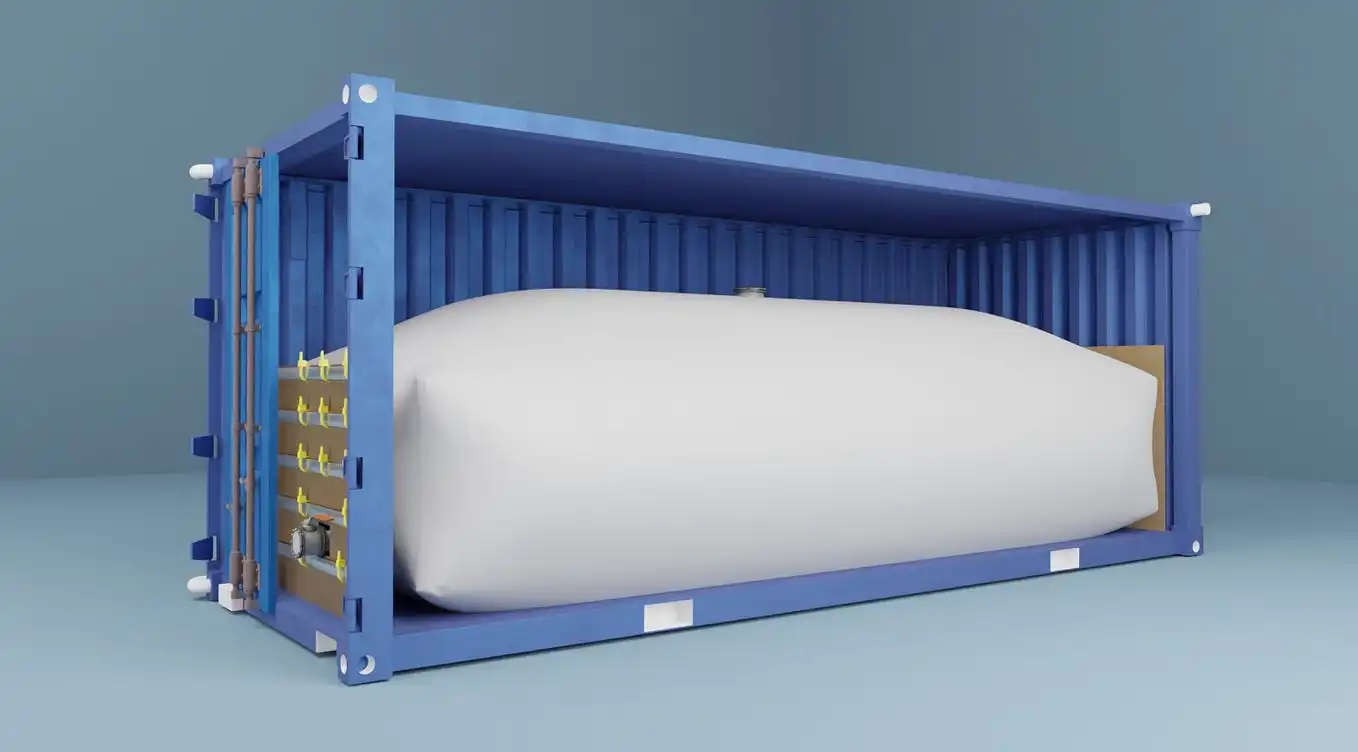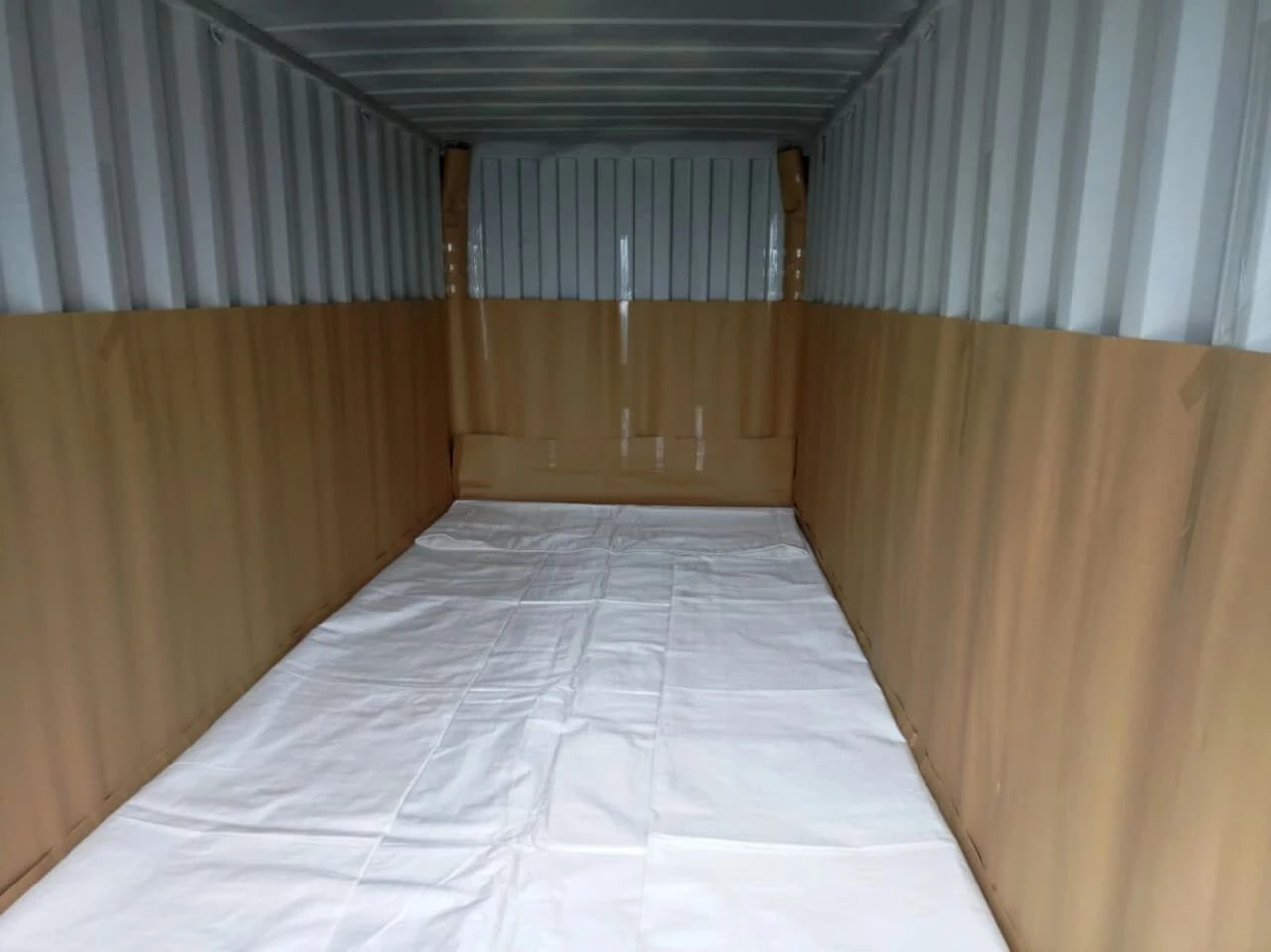 Flexitank Packaging
Flexitank Packaging
BITUMEN IN FLEXITANK PACKAGING
A Flexitank is a specialized packaging for bitumen and other liquid petrochemicals. It’s great for safe, non-corrosive liquids. Its cost-effectiveness and eco-friendliness have made it a hit across industries. Unlike steel drums and IBC containers, it can hold more bitumen. Flexitanks come in single and multi-layered designs and are classified by the number of valves, such as single-valve or two-valve types. The weight of a Bitumen Flexitank depends on its capacity, which ranges from 14,000 to 24,000 liters, fitting into a 20 ft. container. For bitumen transportation using Flexitanks, each Flexi tank can carry up to 20 tons per 20-foot container. It’s crucial to note that Flexitanks cannot be used in 40-foot containers because they require protection on all four sides from the container’s body.
SIMPLIFIED STEPS FOR FLEXITANK HANDLING
The weight of a Bitumen Flexitank depends on its size, which ranges from 14,000 to 24,000 liters and fits neatly into a 20 ft. container. When using a Flexitank for bitumen transportation, each one can carry up to 20 tons in a 20-foot container. Keep in mind that Flexitanks are not suitable for 40-foot containers as they need protection on all sides from the container’s structure.
Proper loading and unloading of flexitanks is crucial to ensuring the safe and efficient transportation of liquid products. Flexitanks are designed for single-use and are commonly used for non-hazardous liquid products. Here are the best practices for loading and unloading both top and bottom discharge flexitanks.
LOADING FLEXITANK
Use Dedicated Hoses: Before loading liquid into the flexitank, ensure to use hoses that are appropriately cleaned and are designed for loading the product that is being transported. Make sure to close the left door of the container and position the valves correctly.
Set Up the Filling Hose Correctly: Set up the filling hose properly to minimise stress on the valve. Ensure that the hose support is at the same level as the valve. This prevents strain on the valve and coupling. Avoid allowing gases to enter the flexitank before and after filling, as gases can affect the quality of liquid products.
Start at a Low Filling Rate: When filling the flexitank, begin with a filling rate of 2000 litres in a minute. After the first 2,000 litres, you can increase the filling rate to 700 litres per minute. Do not exceed 1,000 litres per minute. Always adhere to the manufacturer’s recommended filling capacity to avoid overfilling or underfilling.
TRANSPORTING FLEXITANK
Install a Spillage Mechanism: When transporting the products, consider installing a spillage mechanism to prevent spillages during transport. This mechanism allows you to inspect for leakages before securing the container for transport.
Secure the Flexitank: Ensure that the vehicle used for transporting flexitanks is equipped with wheel chocks. This will reduce the movement of the liquid during transit, ensuring it reaches its destination in proper condition.
UNLOADING FLEXITANK
Have a Spill Prevention Mechanism: When unloading the cargo, use drip trays and other mechanisms to prevent waste. Start by opening the right-side door of the container, keeping the left-side door closed until the flexitank is nearly empty. Remove any markings on the container, indicating that it’s safe for future use.
ESSENTIAL CONSIDERATIONS FOR TOP AND BOTTOM DISCHARGE FLEXITANKS
Secure Flexitank in the Container: When installing a flexitank, ensure that it is fastened securely to all the corners of the container to prevent shifting during transportation.
Check Flexibag Capacity: Check the flexibag’s capacity and fill it only to the recommended capacity. Overfilling and underfilling should be avoided, with a maximum tolerance of 2%.
Valve Handling: For bottom discharge flexitanks, open the tank’s valve by removing the safety cap and locking pin, then pull the valve’s lever outward. Ensure that the loading hose coupling is correctly fitted into the valve. For bottom discharge flexitanks, ensure that the loading hose is correctly supported to prevent downward pulling on the flexitank.
Prevent Hose Trapping: When the flexibag is full, reposition the hose to ensure it is not trapped between the flexitank and the container’s sidewall.
Secure after unloading: Close the valve, turn off the pump, and insert a locking pin in the handle. Clean any remaining product from the hose, thoroughly clean the valve, and place a warning label on the left door of the container.
By adhering to these best practices, you can ensure a safe and efficient loading, transport, and unloading of flexitanks, protecting your liquid cargo from damage and contamination throughout the journey.
MATERIAL COMPOSITION OF BITUMEN FLEXITANKS
The material used in Bitumen Flexitanks is typically polyethylene and polypropylene. These flexitanks can handle hot liquids at temperatures exceeding 120 degrees Celsius. This material is strong and can withstand the pressure exerted by the liquid inside the flexitank. It ensures that the flexitank remains undamaged during loading, easy filling, and unloading of molten bitumen.
| Height | Length | Width | Capacity | Material |
| 170 cm | 580 cm | 240 cm | 14000 – 24000 | Polyethylene Polypropylene |
HOW TO USE BITUMEN IN FLEXITANK?
- Insulate the container walls before entering the refinery area to protect the flexitank.
- Fill the flexitank with molten bitumen, up to a maximum net weight of 20 tons, using a pipe. The bitumen should not exceed 110 degrees Celsius.
- Leave the filled flexitank in an open door container for several hours until the bitumen solidifies to match the ambient temperature. Close the container during this time.
- After inspection and sealing of the container doors, transfer the containers to the ship’s deck for transportation.
- Upon reaching the destination, place the containers on a gentle slope and remove the bitumen after unloading from the ship.
COMPARED TO OTHER BITUMEN PACKAGING METHODS, USING A BITUMEN FLEXITANK OFFERS SEVERAL ADVANTAGES:
- Eco-friendly: Flexitanks are environmentally friendly.
- Efficiency: Using a single flexitank is more convenient than dealing with 110 drums or 20 jumbo bags per container, making unloading operations easier.
- Cost-effectiveness: Flexitank packaging is more affordable than other types of bitumen packaging.
KEY CONSIDERATIONS FOR USING FLEXITANK TO TRANSPORT BITUMEN:
- Careful Handling: Since each flexitank carries 20 tons of bitumen, cautious filling, transport, and unloading procedures are crucial to prevent damage.
- Controlled Environment: Flexitanks are loaded with solid bitumen at room temperature and pressure. During off-loading, maintain the bitumen at room temperature and gradually adjust the ramp and temperature to ensure safe unloading.
LEARNING ABOUT DIFFERENT FLEXITANK TYPES
Standard Flexitanks: They are specifically designed for 20-foot containers and are suitable for storing and transporting non-hazardous bulk liquids. These flexitanks are single-use and provide a safe and efficient way to transport liquid products.
EVOH Barrier Flexitanks: These flexitanks are used for shipping bulk wines and juices to prevent oxygen ingress.
Reeflex Flexitanks: They are designed for products that require a temperature below ambient, such as dairy products.
Aseptic Flexitanks: These tanks are protected from contamination and are therefore used for transporting sensitive liquids such as milk and juices.
Multilayer Flexitanks: These flexitanks are made with 3 or 4 layers of thin and flexible polyethylene for easy rolling after use.
Monolayer Flexitanks: They feature a single, thicker layer of polyethylene to prevent products from getting trapped between layers.
Bilayer Flexitanks: They combine the advantages of monolayer and multilayer flexitanks, with a hard inner layer and a protective twisted layer.
Upload/Download Above: With a valve on top of the flexitank, this system requires climbing for connection and disconnection.
Upload/ Download Below: a valve on the bottom front, making loading and unloading simple and safe.
Dual: This type of flexitank allows two different products to be carried in the same container, often used for shipping bulk wine.
T-Flex (Flexitank for Auto-Trailer): They are a specialised type of flexitank for transporting non-hazardous liquid products in auto-trailers. These flexitanks offer high loading capacity and are easy to install.
R-Flex (Flexitank for Refrigerator Truck): Designed for transporting large volumes of non-hazardous liquids in heat-insulated vehicles, it offers easy installation and efficient use of space.
Medium-Duty Flexitanks: These include various container solutions like 1000-litre bags or K-Flex to transport food products and other liquid loads, Bag in Box, flexible canisters, and paper IBC-tanks.
Liner Bag: They feature an inlay made from polymer for solid friable or dry bulk cargo transportation in standard containers. These inlays are used in different sizes for different types, and the construction varies depending on the kind of loading equipment used.
The choice of the flexitank depends on the specific requirements of the cargo, mode of transportation, and other logistical considerations. Understanding the various types and their advantages helps you streamline your liquid cargo logistics and ensure the safe delivery of the products.
SPECIFICATION AND ADVANTAGES OF FLEXITANKS
Bitumen flexitanks have become a revolutionary packaging solution that is transforming the transportation of bitumen and liquid petrochemicals. They are suitable for non-corrosive and non-hazardous liquid products. The cost-effectiveness and eco-friendliness have made them a popular solution in the industry. The number of valves categorise them into different types including single valve and two valves.
- Bitumen flexitanks have become a revolutionary packaging solution that is transforming the transportation of bitumen and liquid petrochemicals. They are suitable for non-corrosive and non-hazardous liquid products. The cost-effectiveness and eco-friendliness have made them a popular solution in the industry. The number of valves categorise them into different types including single valve and two valves.
- Once the Flexitank reaches its maximum net weight capacity of 20 tons, it is advisable to place it in an open door container for several hours. This period allows the molten bitumen to undergo a transition from a liquid to a solid state. During this phase, maintain the bitumen temperature at the ambient level, ensuring the container is securely closed.
- Following the necessary inspection and custom sealing of the container doors, the containers are then transferred to the ship’s deck. At the destination, a crucial step involves placing the containers on a low slope to facilitate the removal of bitumen after leaving from the ship. This meticulous process ensures the effective and secure use of Bitumen Flexitanks throughout the transportation cycle.
 Flexi Tank Isolation
Flexi Tank Isolation
KEY POINTS FOR USING FLEXITANKS IN BITUMEN TRANSPORT
With each flexitank capable of storing 20 tons of bitumen, careful attention is vital during filling, shipping, and unloading to prevent potential damage. Unplanned unloading should be avoided at all costs. During loading, solid bitumen is used at room temperature and pressure, and the same room temperature should be maintained during unloading. Gradual adjustments to ramp and temperature are necessary during offloading to ensure a smooth process without damage to the cargo or flexitank. Bitumen Flexitank Specification and Advantages highlight how flexitanks offer a comprehensive and efficient solution for bitumen transport, addressing industry challenges with durability, capacity, and eco-friendliness. Embracing Bitumen Flexitanks reflects a commitment to streamlined processes, environmental awareness, and safeguarding valuable cargo throughout its journey.
For more information, please Contact our Sales Team.

